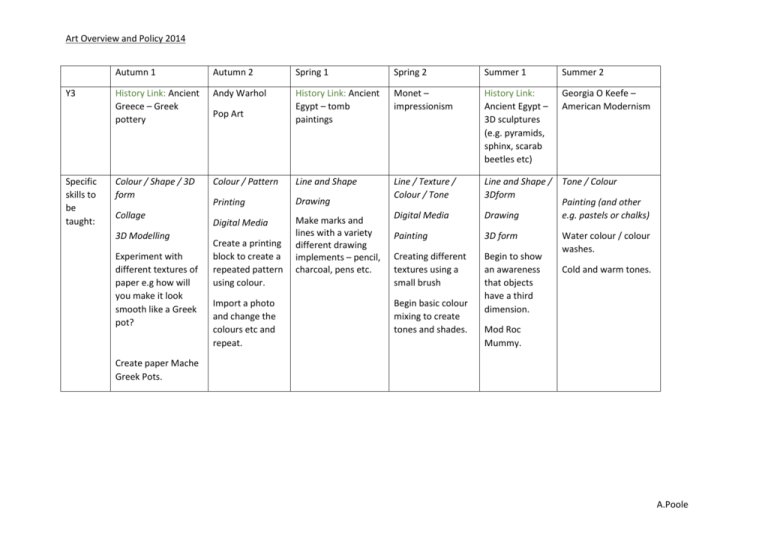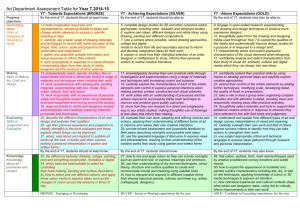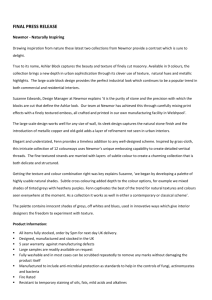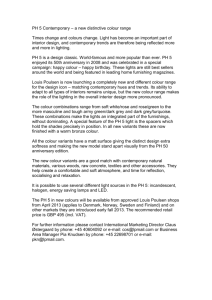Art Overview and Policy 2014 Autumn 1 Autumn 2 Spring 1 Spring 2
advertisement

Art Overview and Policy 2014 Y3 Specific skills to be taught: Autumn 1 Autumn 2 Spring 1 Spring 2 Summer 1 Summer 2 History Link: Ancient Greece – Greek pottery Andy Warhol History Link: Ancient Egypt – tomb paintings Monet – impressionism History Link: Ancient Egypt – 3D sculptures (e.g. pyramids, sphinx, scarab beetles etc) Georgia O Keefe – American Modernism Colour / Shape / 3D form Colour / Pattern Line and Shape Drawing Line and Shape / 3Dform Tone / Colour Printing Line / Texture / Colour / Tone Digital Media Drawing Painting 3D form Creating different textures using a small brush Begin to show an awareness that objects have a third dimension. Collage 3D Modelling Experiment with different textures of paper e.g how will you make it look smooth like a Greek pot? Pop Art Digital Media Create a printing block to create a repeated pattern using colour. Import a photo and change the colours etc and repeat. Make marks and lines with a variety different drawing implements – pencil, charcoal, pens etc. Begin basic colour mixing to create tones and shades. Painting (and other e.g. pastels or chalks) Water colour / colour washes. Cold and warm tones. Mod Roc Mummy. Create paper Mache Greek Pots. A.Poole Art Overview and Policy 2014 Autumn 1 Autumn 2 Spring 1 Spring 2 Summer 1 Summer 2 Y4 Geography Link: Baroque – Linked to Geography topic of Rome – Bernini sculptures Picasso – Cubism History Link: Romans – Roman mosaics Seurat – Pointillism History Link: Anglo Saxons – Illuminated letters Calder – Kinetic Art Specific skills to be taught: Line and shape / 3D form / tone Colour / Line and Shape Pattern / Texture / Line and Shape Colour / Tone Line and shape 3D form Painting Drawing 3D modelling Digital Experiment with combining the use of different media – e.g a painted background and fine liner or pencil crayon with biro etc and comment on the different effects achieved. Making accurate nets Drawing 3D Modelling Apply tone to a drawing in a simple way. Experiment with different grades of pencil. Work on joining clay and creating an adequate base for a clay model. Painting Digital Media Experiment with applying paint with different implements e.g. cotton bud, lollypop sticks, scrunched paper etc. Continue to develop / build on colour mixing from yr3 Experiment with different paint effects, such as blocking colours. Collage Experiment with tessellation and leaving spaces between pieces of a mosaic. Create different effects with paint, experiment with different ‘dot’ sizes Use 2Paint a picture to experiment with digital brush sizes and brush effects. Adding materials to create texture and movement e.g. pieces of fabric / paper / tissue paper / wire coat hangers. Use different size paint brushes. Import photographs and manipulate the images to create a Picasso style image. A.Poole Art Overview and Policy 2014 Autumn 1 Autumn 2 Spring 1 Spring 2 Summer 1 Summer 2 Y5 History Link: Vikings – Norse Art Kandinsky Expressionism History Link: Mayan – Mayan Stelae sculptures Goldsworthy Photography History Link: Mayan –Mayan murals Lichtenstein – Pop Art Specific skills to be taught: Line and Shape / Tone Colour 3D form / Line and Shape 3D form Texture Digital Various media. Tone / Colour / Pattern Awareness of composition – foreground, background etc Experiment using different media on different surfaces such sand paper, stones etc. Drawing Painting or collage 3D Modelling Printing Experiment with cross hatching in pencil / pen / pencil crayon etc Become more confident using shading with appropriate grades of pencil. Identify and work with contrasting colours / complimentary colours etc and comment on how effective they are. Plan a sculpture through drawing. Develop use of a wider range of clay tools Create layered images using digital cameras and ICT. Use oil pastels Identify and use primary and secondary colours. Print with 2 and 3 overlaying colours A.Poole Art Overview and Policy 2014 Y6 Autumn 1 Autumn 2 Spring 1 Spring 2 Summer 1 Summer 2 History Link: Renaissance art (1400’s) Dali - Surrealism Geography Link: – South America – Omar Rayo Faberge Geography Link – South American carnivals Klimt – Art Nouveau Tone Tone 3D form / Texture Texture / Colour Pattern / Colour Drawing Drawing Line and Shape / Texture / Colour / Pattern / 3D form Paper Mache Collage Painting Using shading to show shadows / reflections. Think about how to add to a paper Mache base using a variety of different materials e.g. string, legs beads etc. for texture. Painting (fabric) Focus on geometric patterns Leonardo Da Vinci Specific skills to be taught: Increased accuracy of scale – drawing faces. More controlled use of shades of different colours including light effects (e.g. light on faces / faces in shadow) Collage Paper weaving to create different looks – experiment with different textures of paper, different thicknesses, different colours etc. Explore origami techniques. Use a variety of visual and tactile media including natural and man-made materials. Tie - Dye A.Poole Art Overview and Policy 2014 Overview Each half term is one ‘unit’ of work where an Artist or Art movement will be studied as a focus. 3 of these will link with either your History or Geography work. The half term that they are studied in is flexible. During each unit of work: Observational work must take place Art vocabulary must be developed Artists work (or the specific movement) must be evaluated critically. This plan shows the minimum that must be covered, you can add to this plan as you feel necessary. The Art curriculum is split into 2 sections: The processes: Drawing, collage, painting, printing, digital media, 3D modelling / construction The visual elements: Line and shape, tone, texture, colour, pattern, 3D form. Encourage the children to use this vocabulary and terminology to describe their own work and the work of others. Each Art lesson should have a WALT related to the specific Art skill being taught. A.Poole Art Overview and Policy 2014 Sketchbooks Sketch books should be used to collate ideas and experiment with different media and paper. These pieces should be annotated to explain their ideas, saying what has influenced their work, what worked well and what didn’t etc. Children should also be encouraged to create ‘final pieces’ that bring together all of their ideas and experimentation. These pieces of work should be given a title as if they were in a real Art Gallery. Sketchbooks will be made up of card covers that can be decorated (as a homework task) with images / influences from an Artist of their choice to make them personalised. Work can then be clipped inside the sketchbook. Assessment Work should be marked on the back of a piece of work or on a post it note, against the WALT. A.Poole






